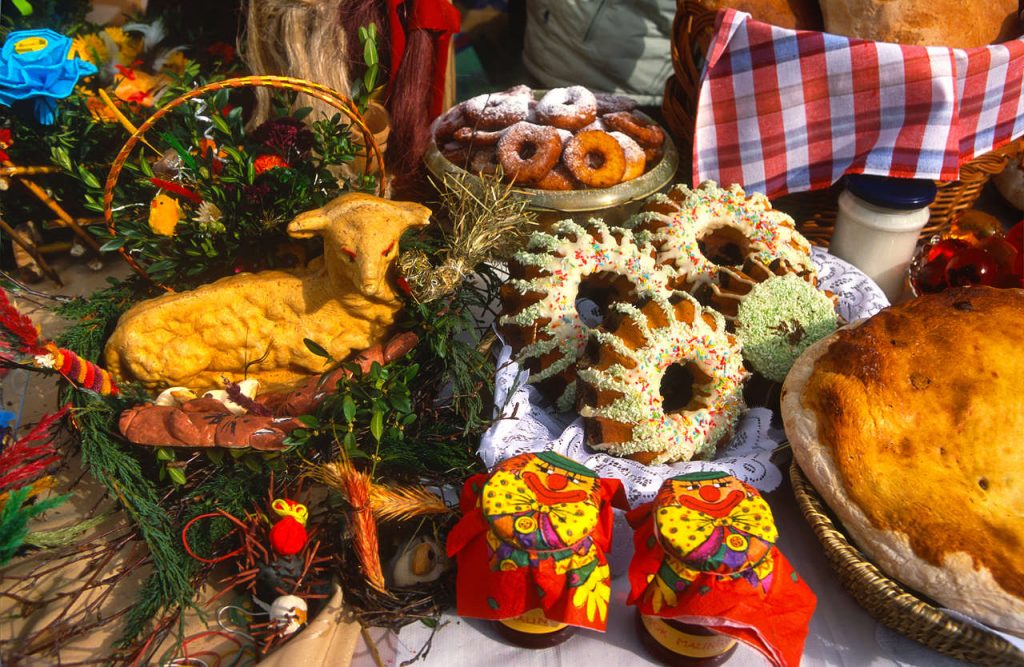Easter is the oldest and the most important Christian feast in Poland. It is a movable feast. It is celebrated on the first Sunday after the first full moon in spring. One of the most beautiful celebrations in calendar. Not as much as Christmas but different and special. Not as spectacular in many ways it is, however, a beautiful symbol of the resurrection of Jesus Christ but also nature coming back to life after a long and tiresome winter.
Easter in Poland
daria
06 April 2020
No Comments
Easter in Poland!
Main religion in Poland is Christianity so for many Poles the Easter preparations starts with 40 days Great Lent before the Ressurection Day. Traditionally, during Lent people were not supposed to eat meat, sweets, alcohol and tobacco in their diet and stick only to light foods and small portions.
Palm Sunday
As Lent is coming to an end, a week before the Easter weekend is Palm Sunday (Niedziela Palmowa). This day commemorates Jesus Christ’s visit to Jerusalem. I know what you are thinking – Where the hell do Polish people take the palms from? It’s too cold for them to grow there! Well, you’re absolutely right about that. In Poland, all we can get are ‘artificial palms’. They’re usually made from branches of native trees, willow birches, branches of box trees, raspberries and currants adorned with flowers, moss, herbs and colourful feathers. Some of the Polish villages and small towns organise palm competitions. The most famous one taking place in Lipnica Murowana (fun fact: the highest palm so far was over 37 meters high and was created in 2019). If you get a chance it is worth attending a mass to join the celebrations. It is a truly remarkable day. If you want to be a part of the celebration you may also buy a read-made piece. If you happen to be in the Mazovian area it is worth considering a trip to Łowicz, a town 86 km west of Warsaw where the traditions of the Mazovian Voivodeship are still alive and well. During Palm Sunday there are people dressed in regional costume following a procession to the church with palms of their own making.
The following days are usually busy as most Poles get their houses cleaned and start getting ready for the weekend. In Poland, whatever big holiday you celebrate it is not about gifts, religion or food. These are all significant components but nothing matters as much as family. Once in Poland you will learn family bonds are probably one of the most important things in this culture.

Palm Sunday
Easter Eggs
On the Easter Friday families gather for a celebratory dinner (possibly excluding meat). Grandmothers and mothers make pound cakes and whole families would make wydmuszki (hollow egg shells) to make Pisanki (Easter eggs). They dip them in hot wax and scratch out the patterns or simply use paints and vegetable broths to colour them.
The eggs, which dominate the Easter table, symbolise life and rebirth. Beautifully decorated, they have adorned Polish tables at Easter for centuries. Although the methods of colouring and decorating eggs have evolved, the tradition has stood the test of time. Traditional patterns on Easter eggs are prepared with hot wax applied to the shell. Eggs are then covered with paint, and finally the wax is removed to reveal the patterns that have been created. The most common symbols on Easter eggs include lambs, crosses, flowers and other spring motifs. You have to imagine that Easter egg is a piece of art. In Poland it was a celebration of Easter especially on the countryside. You can even participate in workshop of making Easter eggs. There is an open air museum where you can make your own Easter eggs in a traditional way!
The decorated eggs are put on the Easter table as a decoration and very often are also used for entertainment. The simple game includes two participants that pick one egg each and hit them against each other. The person whose egg didn’t crack wins.

Easter Eggs
Easter Basket - Święconka
This day is probably the most fun for kids since every house prepares what in Poland is called Święconka – a ceremonial basket filled with a variety of foods. Each basket is different in size, shape, decoration, content, however all of them have things in common. Each Easter basket must have a piece of sausage, bread, salt, pepper, hard-boiled eggs, fresh cress or oats and, of course, a small sugar or butter lamb. These are the basic requirements but depending on the area. You can find different food in the baskets. During a visit to a church a priest blesses the foods.

Easter Basket
Easter Breakfast
On Easter Sunday after the Sunrise Service, families sit down and eat together. Tables are covered with a white cloth and are decorated with Easter eggs, fluffy chicks, and catkin or fresh flowers, which create a spring atmosphere. The basket with blessed food is placed in the centre. Easter breakfast begins with sharing blessed eggs, a tradition with similar symbolic significance to the sharing of the Christmas wafer. The food that was blessed on the previous day is eaten first. Then follow the traditional sour rye soup, meat, cold cuts, pâté, stuffed eggs, and for dessert: babka (sweet yeast cake), cheesecake and mazurek (pastry with a generous layer of chocolate or dulce de leche decorated with dried fruit and nuts). Usually breakfast takes around 3 hours 🙂
No matter how much you hear about different traditions around this day it is mostly about eating and spending time with your family and friends. Have no shame and help yourself to your third piece of mazurek!

Traditional Easter food
Easter Bunny
Easter in Poland isn’t really about gifts, however, small presents are given to children. Children believe that a giant Easter Bunny goes from house to house and hides sweets somewhere in the room or the garden the night before Holy Sunday. Children love being given chocolate bunnies, chicks and lambs.
Who knows, maybe it’s true?

Easter lamb
Easter Monday
Śmigus–Dyngus – Wet Monday is celebrated on the second day of Easter. On this day, people splash others with water: both relatives and strangers. The tradition comes from old pagan customs related to the symbolic awakening of nature and spring cleansing of dirt and illnesses. Girls that were soaked on this day increased their chances of getting married.
There are probably a few other regional Easter traditions and customs, however, you should know now enough to get by and be able to enjoy Easter in Poland. Focus on food and just go with the flow.
Happy Easter!
Aneta and Daria
© Copyright 2018 nicdark.com
Best Travel WordPress Theme


